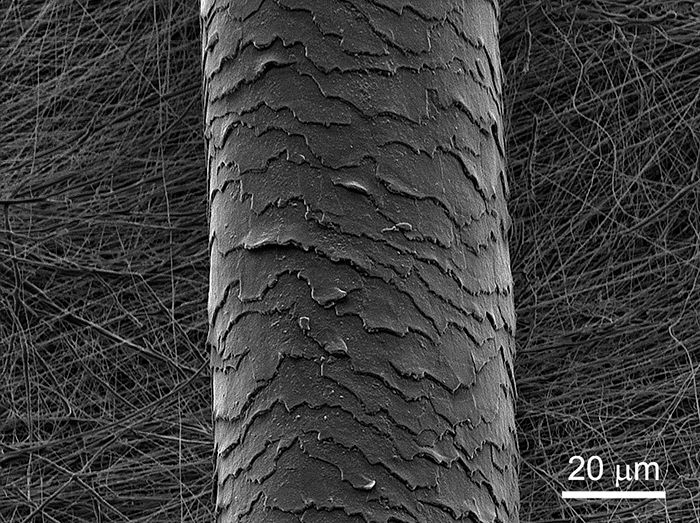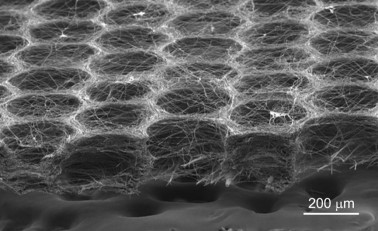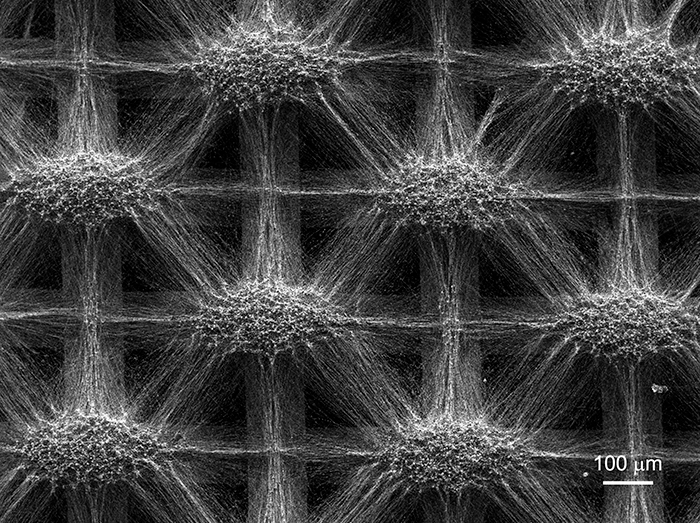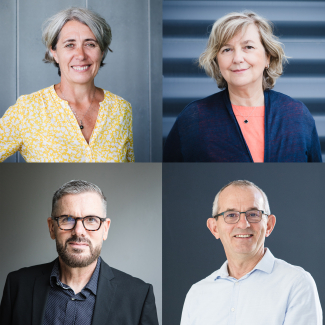
Michelin, the CNRS, and the University of Strasbourg are joining forces to develop innovative nanofibrous materials
|
Michelin, the CNRS, and the University of Strasbourg inaugurated the SpinLab associated research laboratory in Strasbourg on 15 April, with a view to studying the electrospinning process for the optimal production of nanofibrous materials, such as adhesives or filtration membranes. The teams will work together over the course of four years to design an innovative electrospinning platform, with the objective of creating innovative and differentiating fibrous materials for diverse applications in mobility, energy, and the environment.
How to manipulate a fibre that is 100 times thinner than a strand of hair?
Manipulating nanofibers during their deposition via a kind of "electrostatic weaving", such is the goal of the joint research project between the Michelin company and scientists from the CNRS and the University of Strasbourg working at the Institute of Chemistry and Processes for Energy, Environment, and Health (CNRS/University of Strasbourg). To this end, the teams will study the physical phenomena to create materials with a fibrous structure that is organised in three dimensions instead of being random.
While traditional textile technologies use the action of mechanical forces to form and deposit fibres, the electrospinning process instead uses electrostatic forces: the fibre is formed and then highly stretched and projected at great speed onto a substrate through the action of an intense electric field. Continuous fibres with a diameter 100 to 1,000 times thinner than a strand of hair are produced and assembled in the form of a “mat,” a non-woven textile whose random structure resembles a cotton veil.

Next-generation fibrous materials for diverse targeted applications
This collaboration will have two major focuses:
- the first is to develop an innovative electrospinning platform to study the physical and physico-chemical mechanisms that produce multi-component nanofibrous materials whose morphology and fibrous composition are controlled.
- the second aims to use electrospinning and environmentally-friendly approaches to develop “mats” with specific characteristics targeted for diverse applications. Special emphasis will be placed on two applications: hydrogen and zero-emission mobility, in addition to adhesives.
The research conducted by the SpinLab associated research laboratory could eventually have applications in other fields, such as medicine (biomimetic implants for tissue engineering, wound dressings, etc.), the environment (air filters, liquid filtration membranes, etc.), and energy (fuel cell membranes, supercapacitator electrodes, etc.).
For Michelin, these advances will notably enable it to address two major issues:
- Structural reinforcement via electrospun mats that allow for slimming down composites, thereby improving functional properties all while using less material.
- The use of non-woven membranes for their properties of permeability and electrical conductivity. The latter can also be soaked in active agents that provide them with additional functionalities.
Next-generation fibrous materials for diverse targeted applications
This collaboration will have two major focuses:
- the first is to develop an innovative electrospinning platform to study the physical and physico-chemical mechanisms that produce multi-component nanofibrous materials whose morphology and fibrous composition are controlled.
- the second aims to use electrospinning and environmentally-friendly approaches to develop “mats” with specific characteristics targeted for diverse applications. Special emphasis will be placed on two applications: hydrogen and zero-emission mobility, in addition to adhesives.
The research conducted by the SpinLab associated research laboratory could eventually have applications in other fields, such as medicine (biomimetic implants for tissue engineering, wound dressings, etc.), the environment (air filters, liquid filtration membranes, etc.), and energy (fuel cell membranes, supercapacitator electrodes, etc.).
For Michelin, these advances will notably enable it to address two major issues:
- Structural reinforcement via electrospun mats that allow for slimming down composites, thereby improving functional properties all while using less material.
- The use of non-woven membranes for their properties of permeability and electrical conductivity. The latter can also be soaked in active agents that provide them with additional functionalities.

© ICPEES

© ICPEES
The establishment of SpinLab was made possible by support from the Carnot MICA Institute.
“The CNRS is thrilled about the creation of this new associated research laboratory with Michelin, which will develop innovative materials for applications in tyres, energy, and adhesives, doing so in keeping with the energy and environmental challenges of our organisation. Michelin is one of our organisation’s key industrial partners, with approximately a dozen active associated research structures, along with numerous research collaborations in connection with shared scientific issues,” indicates Jean-Luc Moullet, the CNRS Chief Innovation Officer.
“The establishment of this new associated research laboratory with the CNRS and the University ofStrasbourg focusing on electrospinning will further strengthen our joint expertise in this innovative process. It offers original and promising prospects for creating new materials for critical uses, with applications in mobility, in addition to medicine, the environment, and energy. These uses are central to the Michelin group’s goal: to manufacture high value-added composites that change our daily lives,” points out Eric-Philippe Vinesse, the company’s Director of Research and Development, and a member of its Group Executive Committee.
“Associated research laboratories are key tools for collaboration between public research and enterprise research, and are in keeping with the partnership policy developed by the Alsace University Innovation Centre created two years ago as part of the research programming law, for which the University ofStrasbourg is the managing institution. The SpinLab associated research laboratory is based on a large-scale partnership, with the primary aim of conducting cutting-edge research addressing major industrial and societal challenges. In addition to being an ambitious scientific project, SpinLab provides an opportunity to increase the university’s resources in support of research. The collaboration will take direct part in training a dozen young doctoral and postdoctoral researchers. It will also contribute to master’s and engineering training programmes through new opportunities for internships and industrial projects for students, as well as through the implementation of a unique, cutting-edge, experimental technology platform that can be used for hands-on training,” explains Michel de Mathelin, University of Strasbourg's Vice President in Chief, and Vice President for Business Relations and Technology Transfer.
About the CNRS
A major player in basic research worldwide, the National Centre for Scientific Research (CNRS) is the only French organisation active in all scientific fields. Its unique position as a multi-specialist enables it to bring together all of the scientific disciplines in order to shed light on and understand the challenges of today's world, in connection with public and socio-economic stakeholders. Together, the different sciences contribute to sustainable progress that benefits society as a whole. (www.cnrs.fr)
About Michelin
Michelin’s ambition is to sustainably improve its customers’ mobility. The leader in the mobility sector, Michelin designs, manufactures, and distributes the tires best suited to their requirements and uses as well as services and solutions to improve transport efficacy.
Michelin also puts forward offers that allow its customers to enjoy unique moments when traveling. Michelin also develops high-technology equipment intended for multiple fields. Based in Clermont-Ferrand, Michelin is present in 175 countries, employs 132,200 people and operates 67 tire factories that, together, produced approximately 167 million tires in 2022. (www.michelin.com)
About the University of Strasbourg
The University of Strasbourg is home to 57,000 students. With its 35 component structures, 70 research units (UR, UMR, UPR), 6 research support units (UAR), 1 joint service unit (UMS), and 6 federative research structures (3 of which are in partnership with the CNRS), it stands out through its multi and interdisciplinary training covering all disciplines in higher education. This instruction is provided by nearly 2,800 academics, including 4 Nobel prize winners and over 5,000 external speakers. It conducts researches of excellence, which made it the leading European university in terms of innovation impact (2017 Nature Index), and also placed it among the world’s Top 150 universities (2018 Shanghai Ranking). (www.unistra.fr)
Detail of the inauguration photo (from left to right and from bottom to top)
Géraud Delorme, CNRS regional delegate for Alsace
Michel De Mathelin, First Vice-President of the University of Strasbourg,
Irène Weiss, Regional Councillor for the Grand Est Region
Françoise Bey, Alsace Councillor for the Alsace European Community
Anne-Marie Jean, Vice-President of the Eurométropole de Strasbourg,
Emmanuel Custodero, Scientific Director, Michelin Group
Guy Schlatter, Scientific Director of SpinLab, teacher-researcher at ICPEES,
Benoit Lafitte, Deputy Scientific Director, Spinlab, Michelin
Christophe Moriceau, Michelin Group Research Director
Stéphane Le Calvé, Associate Director, ICPEES

